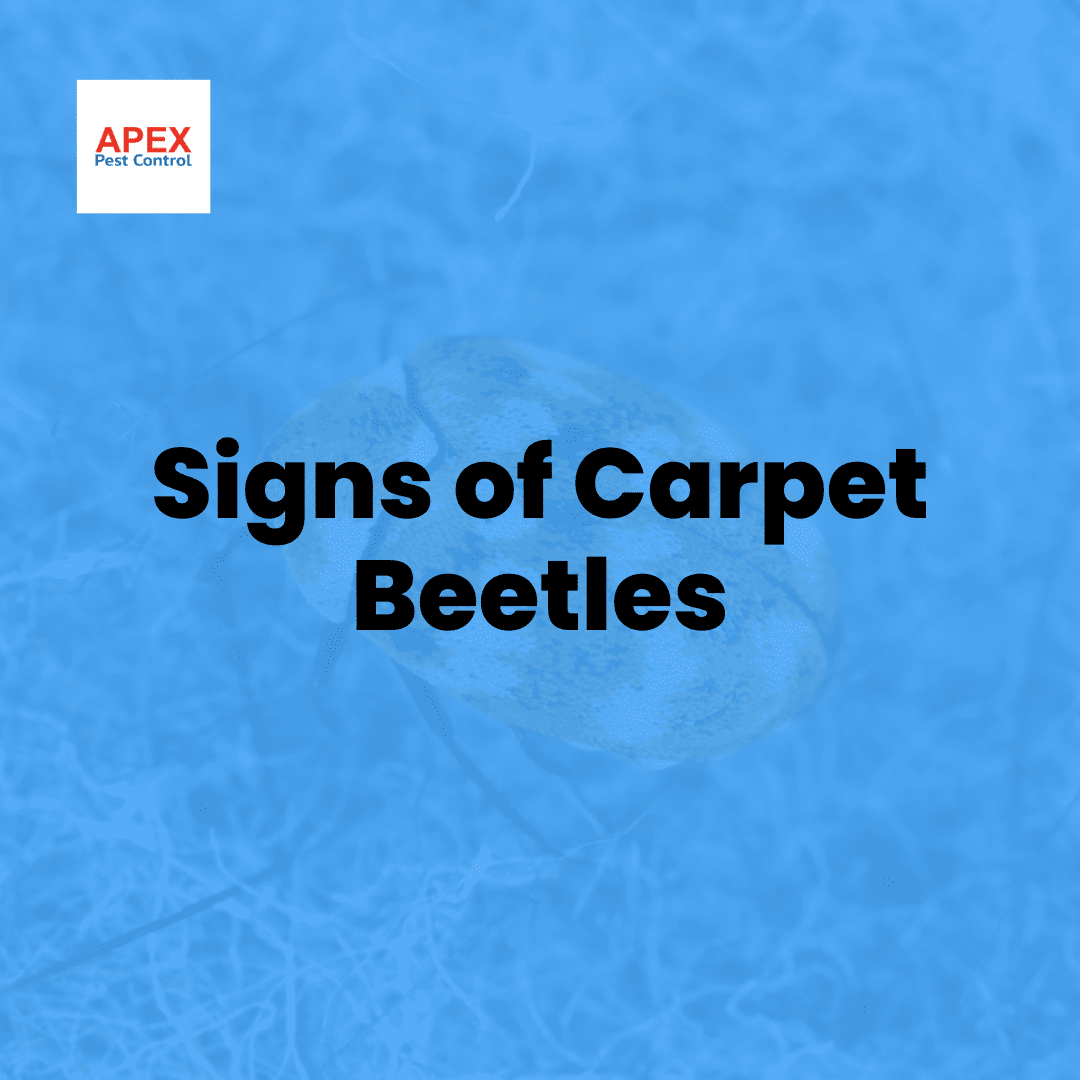Signs of Carpet Beetles
Unseen intruders can quietly invade our homes, causing damage to fabrics and creating quite a nuisance. Carpet beetles are often undetected culprits, silently wreaking havoc on our belongings.
Plunge into the cryptic world of carpet beetles, uncovering the telltale signals that may indicate their presence. From the faintest clues to more conspicuous hints, understanding the signs of carpet beetles is essential for safeguarding your home against these stealthy invaders.
Join us as we unravel the mystery and learn how to spot these unwanted guests before they cause irreparable damage, providing you with peace of mind.
If you already know you have a carpet beetle infestation in your property, please read our post on how to get rid of carpet beetles.
Identifying Carpet Beetles

These pests can be recognised by their physical characteristics, such as their small size and oval-shaped bodies.
There are several common types of carpet beetles to be aware of, including the black carpet beetle and the varied carpet beetle.
Physical Characteristics of Carpet Beetles
Spotting adult carpet beetles is crucial for early detection. These small, oval-shaped insects measure between 1/8 and 3/16 of an inch. They are flying insects with a shiny black or dark brown colour and may have yellow or white scales on their bodies. They have a round body covered in coloured scales, ranging from brown to black, and even have white, orange, or yellow patterns.
Common Types of Carpet Beetles
The most common types of carpet beetles include the varied carpet beetle, the black carpet beetle, and the furniture carpet beetle.
- Varied carpet beetles are about 1/8 inch long and have speckled white, brown, and black patterns on their wings.
- Black carpet beetles are slightly larger, measuring around 1/8 to 3/16 inch long, and are solid black.
- Furniture carpet beetles are similar in size to black carpet beetles but have a mottled pattern of white, brown, and yellow on their wings.
Identifying these common carpet beetles is essential to detecting an infestation and preventing further damage caused by their larvae.
Signs of Carpet Beetle Infestation

To identify a carpet beetle infestation, look for these signs. Keep an eye out for visible adult beetles or larvae crawling around.
It may indicate an infestation if you start noticing damage to your carpets and other fabrics, such as holes or chewed edges.
Shed skins and faecal pellets left behind by the beetles can indicate their presence.
Visible Adult Beetles or Larvae
The larvae are elongated and covered in bristle-like hairs. They’re usually light brown or tan and can be up to 1/4 inch long. Carpet beetle larvae feed on several materials, including carpets, upholstery, clothing, and even dead insects.
If you notice shedding skin or small, irregular holes in these items, it could signify a carpet beetle infestation.
Damage to Carpets and Other Fabrics
Carpet beetle infestations can cause significant damage, leaving visible signs on carpets and fabrics. These pests feed on fibrous materials, such as wool and silk, threatening your valuable textiles.
One of the most common signs of carpet beetle damage is the appearance of small, irregularly shaped holes in your carpets or fabrics, including holes in clothing. These holes are usually dark brown and can vary in size.
Another sign to look out for is the presence of shed larval skins, which are often found near infested areas. Different types of carpet beetles may leave different damage patterns. Still, depending on the species, it’s important to address the infestation promptly to prevent further destruction to your carpets and fabrics.
Shed Skin and Faecal Pellets
The larvae often leave faecal pellets and shed skins behind as they moult and grow. These skins can be found near areas where the beetles are active, such as carpets, upholstery, or clothing made of fibrous material.
Faecal pellets are small, cylindrical droppings that are usually brown or black. These pellets result from beetles feeding on fibrous materials like wool, fur, or feathers.
If you spot shed skin or faecal pellets in your home, it’s important to take immediate action to prevent further damage to the fibrous material. Inspect your carpets, furniture, and other susceptible items for signs of larvae or beetles.
Locations Where Carpet Beetles Are Commonly Found

These pests prefer dark and undisturbed areas, such as closets, attics, and basements.
They tend to infest common household areas like carpets, rugs, upholstered furniture, and stored clothing.
Preferred Habitats of Carpet Beetles
You will commonly find carpet beetles in several locations, such as homes, offices, and warehouses. These pesky insects can infest and cause severe damage to your belongings.
Carpet beetles hide in hidden corners, such as under furniture or behind baseboards, making it difficult to detect their presence. Regularly inspecting and vacuuming these areas thoroughly to prevent infestations is important.
Storing items in sealed containers can help protect them from carpet beetles. By being vigilant and taking preventive measures, you can avoid the costly damage caused by these unwanted pests.
Common Household Areas Infested by Carpet Beetles
Carpet beetles are commonly found in various household locations, including furniture, carpets, and clothing made from natural fibres. These pests can infest other household items, such as curtains, blankets, and stuffed animals.
Carpet beetles live and breed in dark, undisturbed areas, making window sills and window frames prime locations for infestations. They’re frequently found in upholstered furniture, where they can hide and deposit carpet beetle eggs in crevices and seams.
It’s important to regularly inspect and clean these areas to prevent an infestation of carpet beetles in your home. Look for signs of carpet bugs, such as small holes or irregular fabric patterns. Taking preventative measures and maintaining cleanliness can help protect your home from furniture and carpet beetles.
Differences Between Carpet Beetles and Other Common Pests

Let’s look into the differences between carpet beetles and other common pests such as bed bugs, fleas, and moths.
Understanding these distinctions is crucial to identifying and effectively dealing with the specific pest problems you may be facing.
Carpet Beetles vs Bed Bugs

Carpet beetles, unlike bed bugs, aren’t blood-sucking insects. They’re primarily attracted to natural fibres, such as wool and silk, and can infest furniture and clothing.
Bed bugs feed on human blood and are commonly found in mattresses, bed frames, and other areas where people sleep.
Another noticeable difference is their appearance. Carpet beetles are usually brown or black and have a distinctive pattern of scales on their wings. Bed bugs are reddish-brown and don’t have wings.
If you suspect an infestation, it’s essential to contact pest control companies or a pest control professional to identify the pest and implement the appropriate treatment accurately.
Carpet Beetles vs Fleas

If you’re wondering how carpet beetles differ from other common pests, such as fleas, there are a few key distinctions to consider. While carpet beetles and fleas can cause irritation and discomfort, they’ve got different behaviours and habits.
One of the main differences is that carpet beetles are attracted to natural fibres, such as wool and fur, while fleas are more commonly found on animals and carpets.
Another distinction is the signs of infestation. Carpet beetles leave behind shed skins and faecal pellets, while fleas leave behind small, dark specks of dried blood.
Concerning damage, carpet beetle larvae feed on fabrics and can cause significant harm to carpets and clothing, while fleas primarily feed on blood.
Carpet Beetles vs Moths

While both carpet beetles and moths can cause damage to your home, they have different ways of doing so.
Carpet beetles are attracted to carpets, clothing, and upholstery. The signs of an infestation include the presence of adult beetles, larvae, shed skin, and dead skin. You may notice small holes or irregular patterns of damage on fabrics.
Moths are attracted to dark, undisturbed areas like closets and storage spaces. The signs of a moth infestation include the presence of adult moths, silken cocoons, and larvae. Moth larvae feed on natural fibres, such as wool and silk, causing visible damage.
Prevention and Control of Carpet Beetles

Using pesticides, including insecticides or boric acid, specifically designed for carpet beetles can effectively prevent them from laying eggs. If the infestation is severe, it may be necessary to hire professional pest control services to thoroughly eliminate the problem, addressing the potential for carpet beetles to lay eggs.
Regular Cleaning and Vacuuming
Maintaining regular cleaning and vacuuming practises is essential for preventing and controlling carpet beetles. Staying on top of cleaning can reduce the likelihood of an infestation and catch any signs of carpet beetles early on.
Regularly vacuuming your carpets and rugs helps to remove any dead insects, larvae, or carpet beetle skins that may be present, as well as any food sources that could attract the pests. Pay extra attention to areas where you have noticed signs of infestation, such as shed skin or faecal pellets.
It’s a good idea to have your home inspected by professional pest control services periodically, to ensure that any potential issues are addressed promptly and effectively.
Use of Pesticides and Insecticides
When dealing with a carpet beetle infestation, it’s important to be proactive in your pest control efforts.
One of the most effective ways to eliminate these pests is by using pesticides and insecticides specifically designed for carpet beetles.
These products are formulated to target and kill adult beetles, as well as their larvae, eggs, and carpet beetle infestations.
Before using any pesticide or insecticide, it’s crucial to carefully read and follow the instructions provided by the manufacturer.
Professional Pest Control Services
Step up your pest control efforts by considering professional services to prevent and control carpet beetles. When dealing with a carpet beetle infestation, it’s important to act promptly to avoid further damage to your belongings.
Professional pest management services can effectively identify and address the root cause of the problem. These experts have the knowledge and experience to accurately identify signs of carpet beetles, such as the presence of adult beetles or larvae, shed skins, or small holes in fabrics.
Health Risks Associated with Carpet Beetles

These tiny insects can cause allergic reactions, such as sneezing, coughing, and watery eyes. Their tiny hairs can irritate your skin and cause itching or rashes.
While rare, carpet beetles can potentially transmit diseases to humans, making it important to address an infestation promptly.
Allergic Reactions
If you have been experiencing allergic reactions, knowing the potential health risks associated with carpet beetles is important. These tiny insects can cause several allergic reactions in individuals who are sensitive to their presence.
One common allergic reaction is skin irritation, manifesting as redness, itching, and rashes. This occurs when the larvae of the carpet beetles come into contact with your skin.
Carpet beetles are attracted to pet hair, so regularly clean and vacuum your carpets, rugs, and upholstery that may harbour these pests.
Skin Irritations
Experiencing skin irritations is a common health risk associated with carpet beetles. When carpet beetles come into contact with human skin, they can cause an allergic reaction known as carpet beetle dermatitis. Red, itchy bumps or rashes on the skin characterise this condition. These irritations are often mistaken for other common skin conditions, such as eczema or hives.
Some common signs can help you identify if carpet beetles cause the irritations. One of the most telling signs is finding shed skins of carpet beetle larvae in your home, these can trigger allergic reactions in sensitive individuals.
Potential Diseases Transmitted by Carpet Beetles
When carpet beetles come into contact with your skin, they can potentially transmit diseases and pose health risks. These destructive pests, known as carpet beetles, can cause significant damage to your home and belongings.
The health risks associated with carpet beetles primarily stem from their ability to carry and transmit potential diseases. Although not common, carpet beetles have been known to carry bacteria, fungi, and even parasites. This risks your health, as these organisms can cause several infections and diseases.
It’s important to be aware of the signs of infestation and take the necessary precautions to prevent the spread of these insect pests.
Regular cleaning, vacuuming, and proper storage of vulnerable items can significantly reduce the health risks posed by carpet beetles. Taking proactive measures to prevent carpet beetle infestations provides an added layer of protection for your home and belongings.
Frequently Asked Questions (FAQs)
How Long Does It Take for a Carpet Beetle Infestation to Spread Throughout a Home?
A carpet beetle infestation takes a variable amount of time to spread throughout a home. Factors such as the size of the infestation and the availability of food sources can determine the speed of its spread.
Are Carpet Beetles Attracted to Certain Types of Fabrics More Than Others?
Carpet beetles are attracted to certain types of fabrics more than others. They prefer natural fibres like wool, silk, and fur. Synthetic materials like polyester and nylon are less appealing to them.
Can Carpet Beetles Cause Damage to Furniture and Upholstery, or Do They Only Target Carpets?
Carpet beetles can cause damage to both furniture and upholstery, not just carpets. They are attracted to certain fabrics and can infest and eat away at them, so it’s important to take preventive measures.
Do Carpet Beetles Bite Humans or Pets?
Yes, carpet beetles can bite people or pets. They are attracted to the oils in our skin and hair. If you notice itchy red welts, it could be a sign of carpet beetle bites.
Are There Any Natural Remedies or DIY Methods for Getting Rid of Carpet Beetles?
There are natural remedies and DIY methods to help get rid of carpet beetles. Try using essential oils, vacuuming regularly, and laundering infested items in hot water. These options can be effective in controlling the population.
| Glossary of Related Terms | Definition |
|---|---|
| Bed Bug Control | The methods and strategies employed to manage and eliminate infestations of bed bugs in residential or commercial spaces. |
| Carpet and Rugs | Textile floor coverings are used for insulation, comfort, and decoration in indoor spaces. |
| Carpet Beetle Adult | The mature stage of a carpet beetle, a common household pest known for feeding on natural fibres like wool and silk. |
| Clothes Moth | A type of moth whose larvae feed on natural fibres in clothing, carpets, and other textiles, causing damage. |
| Gaps Around Doors | Open spaces or crevices around doors may serve as entry points for pests if not properly sealed or addressed. |
| Ground for Carpet Beetles | Suitable environments or conditions on the ground where carpet beetles may thrive, including factors like temperature and humidity. |
| Larvae on Furniture | The immature stage of insects, particularly those like carpet beetles, found on or infesting furniture items. |
| Life Stages | The various developmental phases in the life cycle of pests, include egg, larva, pupa, and adult stages. |
| Pests Infest | The range of pests that can invade and infest living spaces, causing damage or posing health risks to humans and animals. |
| Wool Fur | Fur is derived from wool-producing animals, which may be a material of interest for pests like carpet beetles. |
| Wool Silk | Textile materials are composed of a blend of wool and silk, which may be targeted by certain pests for feeding or nesting. |
| Animal Products | Items derived from animals, such as fur or hides, may be susceptible to damage from pests. |
| Bristly Hairs | Coarse or stiff hairs are often found on certain insects or pests, serving various purposes such as protection or sensory functions. |
| Cabinets | Furniture pieces with enclosed spaces, commonly found in kitchens, may require attention to prevent pest infestations. |

Tony Johnson, Founder & Lead Technician at Apex Pest Control, is a BPCA and NPTA accredited pest management expert with over 35 years’ hands-on experience. Tony specialises in Integrated Pest Management and ensures all services comply with UK pest legislation, including the Wildlife and Countryside Act 1981 and COSHH Regulations 2002. His commitment to continual learning and adapting to industry best practices means clients receive effective, safe solutions for pests affecting homes and businesses across South Yorkshire. Tony’s dedication to professional standards, ethical treatment methods, and local expertise has made him a trusted partner for pest control and prevention.
-
BPCA & NPTA accredited | CHAS certified
-
Committed to UK pest law compliance & safety
-
Focused on effective, ethical pest management for South Yorkshire


